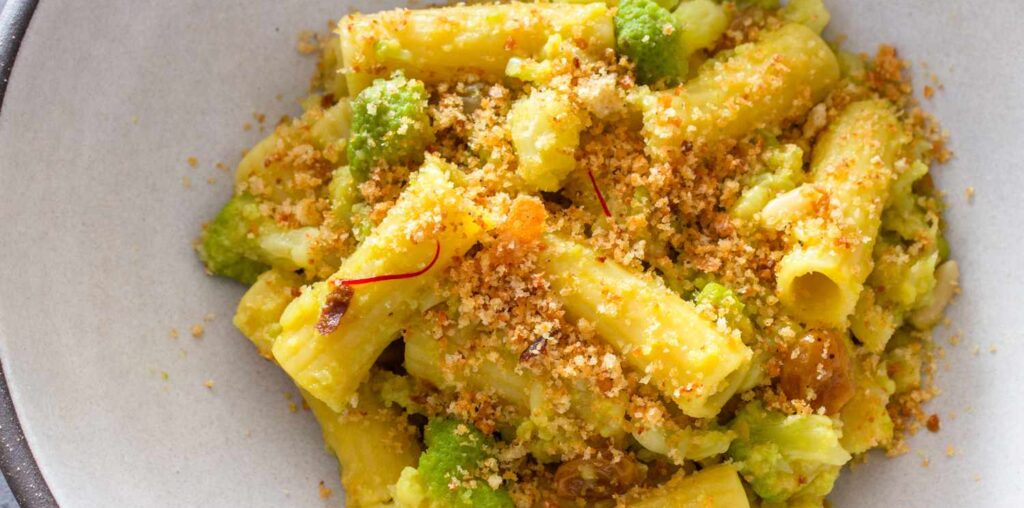Why It Works
- Extended cooking and vigorous stirring makes cauliflower break down into a hearty sauce.
- Sicilian pantry staples—anchovies, raisins, pine nuts, saffron, and toasted breadcrumbs—strike a characteristic savory-sweet balance with North African influence.
- A sprinkling of toasted crumbs gives the finished pasta a crunchy topping.
Sicilian cuisine is famous for its mix of savory, sweet, and sour flavors, evidence of the heavy influence on the island of centuries of North African and Spanish rule. To produce that combination of flavors, Sicilian cooks turn to pantry ingredients like anchovies, saffron, pine nuts, and raisins, and toasted breadcrumbs. In Palermo, the region’s capital, the way these staples are used together is evident in a trio of pasta dishes: pasta con le sarde (pasta with sardines), pasta c’anciuova e muddica atturrata (pasta with anchovies and toasted breadcrumbs), and pasta chi vruoccoli arriminati (pasta with stirred cauliflower).
My friend Salvatore Agusta, a native Palermitano and sommelier who also runs a business organizing street food tours in the city, compares this grouping of pastas to Rome’s Big Four: “It’s similar to how carbonara, gricia, amatriciana, and cacio e pepe share black pepper, Pecorino Romano, and guanciale, with varying amounts of each and additions of other ingredients like tomato or egg to achieve dishes that taste distinctly different, but also echo and complement each other. In Palermo, we have our ingredients—anchovies for umami, saffron for floralness, pine nuts for nutty bitterness, raisins for sweetness, and breadcrumbs for their salty crunch. Combining them with sardines, or tomato estratto, or in this case cauliflower, gives us three unique pastas with shared commonalities.”
For pasta chi vruoccoli arriminati, it’s the intentionally overcooked cauliflower that sets the dish apart. Not to be confused with broccoli, Sicily’s “broccolo,” or “vruocculu” in Palermo dialect, is what we know as cauliflower, and its peak season is in the fall. While most types of cauliflower will work for this recipe, light green varieties, like Romanesco, are ideal.
The Cauliflower
You start the process by trimming a head of cauliflower into florets and simmering them in salted water until they’re tender enough to crush with a wooden spoon. You then add them to a skillet in which chopped onion has been gently cooked with anchovies in olive oil. Scoop some of the water you used to cook the cauliflower into the pan, along with the familiar cast of raisins, toasted pine nuts, and a pinch of saffron*, and bring everything to a simmer. At this stage, that cooking water is doing a lot of heavy lifting: it’s helping to break down the cauliflower, plump the raisins, bloom the saffron, and soften the pine nuts. And now it’s “arriminare,” or stirring, time.
Salvatore also recommends adding a pinch of fennel pollen, which complements the floral notes of the saffron (I tested this recipe with and without it, and it’s a great optional addition).
Stirring, Smooshing, Swirling
As the sauce ingredients come to a simmer, get to work with a wooden spoon, stirring, smooshing, and swirling the florets, coaxing them to break down and thicken the liquid in the pan to take on a thick, saucy consistency. While that’s happening, you cook the pasta until just shy of al dente in the same cauliflower-cooking water; short, tubular sedani or long bucatini are the shapes of choice. Finish the pasta in the skillet with the sauce, then top each serving with a sprinkling of breadcrumbs for crunch. The nutty sweetness of the cauliflower plays off the pine nuts and raisins, the savory anchovies do their thing in the background, and even though it’s got close relatives in Palermo, one taste will tell you this is a vegetable pasta unlike any other.
March 2021
This recipe was cross-tested in 2023 and updated to guarantee best results. We increased the amount of saffron, raisins, and pine nuts, and we now call for garnishing the pasta with breadcrumbs instead of tossing it with the pasta.

